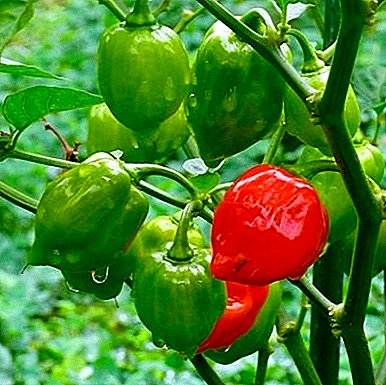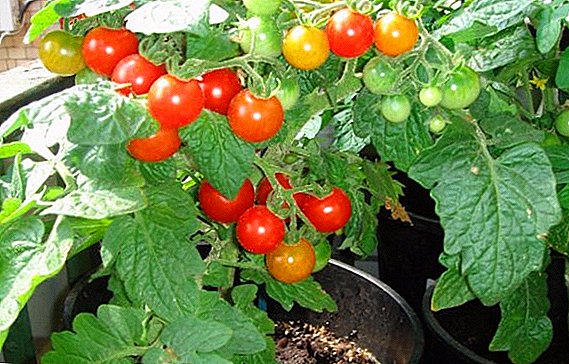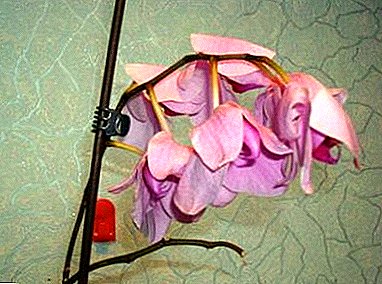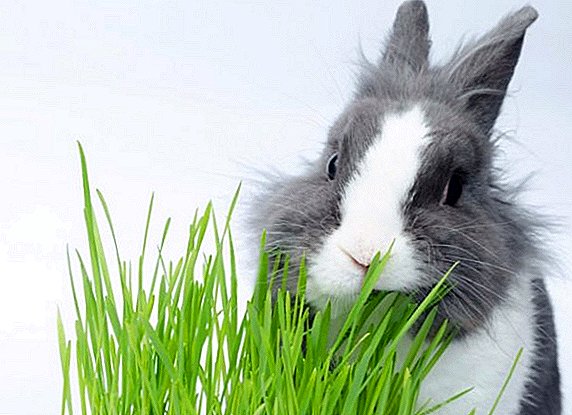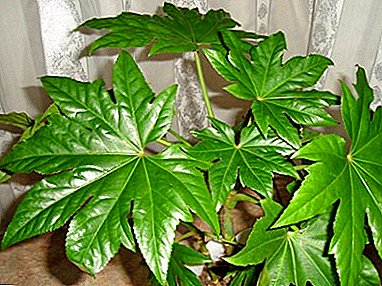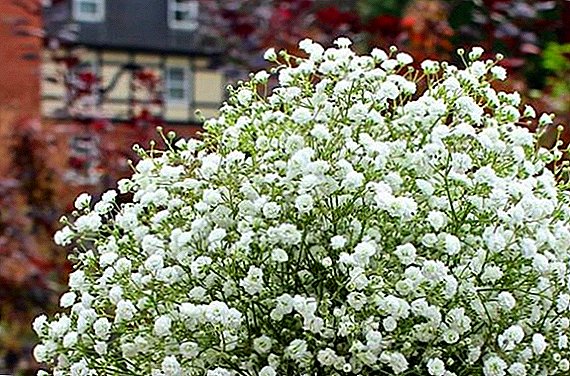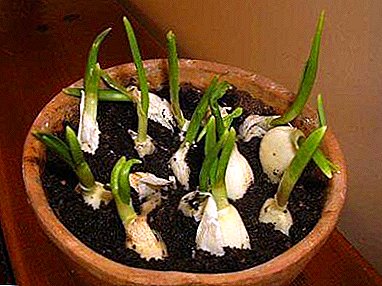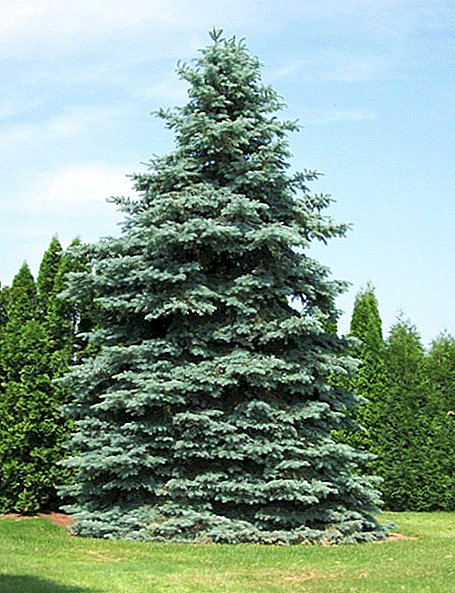 If you have decided to refresh the appearance of your plot, using for this purpose a coniferous tree - pay close attention to the spruce tree Glauka. This tree is perfect for creating compositions, and as a single planting. It is undemanding to environmental conditions, resistant to frost and does not require heavy care. You can learn more about what kind of tree it is, how to plant it and how to take care of it, you can by reading this article.
If you have decided to refresh the appearance of your plot, using for this purpose a coniferous tree - pay close attention to the spruce tree Glauka. This tree is perfect for creating compositions, and as a single planting. It is undemanding to environmental conditions, resistant to frost and does not require heavy care. You can learn more about what kind of tree it is, how to plant it and how to take care of it, you can by reading this article.
Botanical description
Fir-tree prickly Glauka - is a coniferous tree, the natural habitat of which is limited to the west of North America. Most often it can be found in the high mountains, along the banks of mountain rivers and streams, where the soil is more saturated with moisture. The characteristic color of their needles is sometimes also called blue spruce.
Did you know? In the western part of Sweden is the Fulufjellet National Park, in which one of the oldest organisms on the planet grows - the European spruce tree "Old Tjikko". Her age is estimated by scientists at 9.5 thousand years.

The main parameters of this ornamental plant:
- height - up to 25 meters;
- crown - the shape of a regular cone, tapering upwards;
- bark - brown-gray, with multiple bulges and grooves;
- shoots - brown-yellow or brown-orange, completely naked, rough to the touch;
- fruits - cones, brownish, oval-cylindrical, 7-10 centimeters long;
- needles - blue, oblong, tough;
- root system - in the first 10-15 years, rod, then - the surface;
- bloom - May - the first half of June;
- rates of growth - up to 30 centimeters per year in height, about 10-15 centimeters per year in girth;
- lifespan - under favorable conditions, up to 300 years;
- frost resistance - high;
- resistance to pests and diseases - average.
Read the description of all varieties of spruce barbed.
Use in landscape design
Due to its unusual color and original form of the crown, this tree will fit very well into any ensemble. Best of all, it will be in harmony with medium-sized plants, green shrubs and flowers of red, yellow and white shades. The most favorable location of the plant is in the center of the composition or in the back part of it.
Best of all, it will be in harmony with medium-sized plants, green shrubs and flowers of red, yellow and white shades. The most favorable location of the plant is in the center of the composition or in the back part of it.
This type of spruce is also very well suited for single landings. Its large size and lush crown will give your site an additional visual area and will contribute to the expansion of the volume of the site. In addition, a lonely standing spruce tree will look great at any time of the year, unlike many deciduous trees.
Did you know? Musical instruments made of spruce wood are considered among the best because of the special distribution of fibers in wood. Decks of Stradivarius violins are made of this tree
Glauka looks good as an integral part of the hedge, however, trees growing in this form require more thorough care and frequent cutting, which to some extent deprives them of their magnificence due to the violation of the natural appearance of the crown.  However, this is more than compensated for by the stunning visual effect that is formed as a result of the fusion of a multitude of trunks with bluish needles on the branches.
However, this is more than compensated for by the stunning visual effect that is formed as a result of the fusion of a multitude of trunks with bluish needles on the branches.
Coniferous plants such as thuja, juniper, cross-pair microbiota, yew, cypress, fir, boxwood, pseudo-hemlock, larch, cryptomeria, pine, cedar and myririum foxtail are also often used in the design of the suburban area.
Growing conditions
From the fertility of the soil on which spruce will grow, the depth of its root system directly depends, and therefore it is better to choose soil for planting, which would be rich in various organic and mineral compounds.
It is desirable before planting the spruce to additionally fertilize the soil. For this spruce, loamy and sandy loam soils are best suited. This tree demonstrates the best growth dynamics in shaded areas, which is associated with special climatic conditions in the natural habitat of the plant.  When planting on overly illuminated areas in hot years, conifer needles may become opacifying, yellowing, wilting, falling off, and if the tree is not sufficiently watered, it may well completely die.
When planting on overly illuminated areas in hot years, conifer needles may become opacifying, yellowing, wilting, falling off, and if the tree is not sufficiently watered, it may well completely die.
This tree is best planted in areas closed from the wind, which is due to the peculiarity of its root system (after 10-15 years of growth in one place, the central root dies, and in the ground the plant is kept only superficially located parts of the root system). The impact of small drafts is not critical for this type of needles.
How to choose a sapling when buying
A healthy Glauki sapling, which has reached the age necessary for planting and has every chance to take root in a new place, must first of all have a well-developed pink-white root system, slightly moist to the touch, in which a clear central root should be traced.
You can also focus on the state of the container in which the plant was put up for sale: if it looks new and not crumpled, then the probability that this plant is relatively young and has normal parameters is quite high.  Next, note the crown color of your coniferous tree. If you notice that its color is dull in comparison with other representatives of this species, if the branches have wilted, you have noticed an abundant yellowing of the needles - you should not buy such a seedling.
Next, note the crown color of your coniferous tree. If you notice that its color is dull in comparison with other representatives of this species, if the branches have wilted, you have noticed an abundant yellowing of the needles - you should not buy such a seedling.
Try to gently bend one of the branches of the tree. In the normal state, the bent branch must very quickly return to its previous position.
If this process takes a long time or does not even occur at all, then this may be evidence of the fact that the seedling is in critical condition and is unlikely to be able to successfully transplant it.
When choosing a sapling, strive to buy smaller specimens, since such trees are more likely to successfully adapt to new growing conditions than those that have been in greenhouse conditions longer and have had time to pamper themselves. As practice shows, within two to three years, small saplings are catching up, or even overtaking their older counterparts in development. 
Landing rules
The two most favorable periods in the year for planting spruce are the end of August and the end of April. It is during these time periods that the root system of these trees enters a phase of the most active development, which allows them to better adapt to the new conditions and enter the vegetative growth phase more quickly.
We recommend reading about how to choose a spruce for the suburban area, as well as how to protect the spruce from diseases.
At first it is worth forming a landing hole for your seedling. The diameter of the pit - 50-55 cm, depth - 50-60 cm.
If the soil is heavy or somewhere close to the site of landing, groundwater accumulation areas are adjacent, then a layer of drainage material (15-20 cm) should be laid on the bottom, for example, broken brick mixed with sand or crushed stone. Before the transplant itself, it is advisable to add mineral fertilizers, for example, a nitroammofoska at the rate of: 1 cup per tree.
Video: how to plant a coniferous plant
Next, it is necessary to pour a small layer of soil mixed with peat and humus over the drainage, and, after removing the seedling from the container, move it into a hole so that the root neck is completely submerged in the ground. It is advisable that the earthen room with which the sapling is transplanted was completely intact and did not suffer at all during the procedure.
Important! It is impossible to plant young spruces into the soil, where for 5-7 years a tree from the same family grew, which is associated with the phenomenon of "soil fatigue", and also because of the possible presence in the ground of remnants of previous plants with parasites living on them.
After filling the pit with sand, weave the ground around the trunk of the seedling loosely and gently. Two water buckets are poured under the transplanted tree, and then mulch the soil around the trunk with peat or any other mulch. The next day after planting, gently rip the soil around the plant to a depth of no more than 5-7 centimeters.
When planting a large number of trees in one area, for example, in the case of the formation of a hedge or avenue, it must be remembered that the distance between two trees should be at least 1 meter, preferably 2-3 meters.  This is due, primarily, to the superficially located root system, which occupies a lot of space around the tree. Too close planting of fir trees will cause them to prevent each other from growing and developing normally.
This is due, primarily, to the superficially located root system, which occupies a lot of space around the tree. Too close planting of fir trees will cause them to prevent each other from growing and developing normally.
Care features
In general, this plant is not too different in the care of its other coniferous brethren, but she sometimes does not need it at all. However, there are some aspects in this process that would not hurt to focus your attention.
Watering and loosening
Regular watering and loosening the soil around this tree is only necessary during the first few years after planting. It should be remembered that the roots spread widely along a large perimeter around the trunk, therefore it is necessary to water and loosen within a radius of 20-30 cm from the trunk, and not just under the base.
Loosen the soil should be very carefully, trying not to exceed a depth of 5-7 cm, so as not to harm superficially located young roots. Watering is best in the morning, or after sunset, the recommended frequency and volume of irrigation - once a week for a bucket of water for each plant.
Watering is best in the morning, or after sunset, the recommended frequency and volume of irrigation - once a week for a bucket of water for each plant.
Important! You can check whether the plant needs watering, if you take a clod of land from a plot near it and squeeze it in your hand. If the crumb is crumbly, it is necessary to water it, if it spreads between the fingers, the ground is too “flooded”, and if the lump keeps the shape, then everything is normal.
With the development of the plant, the need for these procedures will decrease every year. Already by the 7-8 year of growth, you can safely leave them without regular care for quite a long time.
At the same time, it is necessary to remember that one loosening in a year should be carried out necessarily - preferably in the beginning of spring. Also required are irrigation in too dry weather at the rate of: 10 liters per plant twice a week. 
Mulching
Matured ate Glauka varieties in mature age, there is no need, but in the first few years after planting it is necessary for two purposes: the first is to preserve moisture during droughty periods, and the second is to increase the thermal stability of roots in too cold winters.
We advise you to familiarize yourself with the cultivation of spruce "Konica", "Nidiformis", as well as the Serbian, blue and ordinary spruce.
It is best to use peat or sawdust as mulch, the layer should be at least 6-8 cm, and the diameter of the mulch circle should be at least 40-50 cm around the trunk. During the spring loosening of the soil, all the mulch, laid to protect the tree from the winter cold, is mixed with the soil.
The summer layer of mulch is stacked depending on how hot and dry the season is. The mulch laid in summer can lie in the tree near the edge of the tree until the onset of cold weather, then the layer is just a little renewed and left to lie so until spring. 
Top dressing
The only top dressing that a normally developing spruce requires is a top dressing when it is planted, which, as we have already mentioned, consists of a nitroammofosca in the amount of one glass under each tree.
However, if you notice a slowdown in the vegetative growth of the plant, see that it loses its presentable appearance, or simply want to spur the natural growth process of the spruce tree, then the tree can be fed during the summer periods.
Feed to enhance growth are carried out according to the following scheme: Weekly alternation of mineral fertilizers, for example, nitroammofoski or ammofoski at the rate of: 1 cup for each tree, and organic fertilizers, for example, diluted with water 10: 1 mullein or fermented chicken manure. 
Fertilizers need to be applied only to the pre-moistened soil, otherwise there is a chance to injure the root system of the tree. The first half of the day is considered the best time of the day for making dressings.
Such a fertilizer application scheme can be carried out for 1–1.5 months without harming the plant and only during the summer period, when the main vegetative growth occurs.
Pruning
Radically cutting this type of spruce only makes sense if it participates in the formation of a hedge and the outline of its natural crown does not fit into the structure formed from wood.
In all other cases, pruning should be done only when you notice the appearance of dry or diseased branches on spruce. It is best to use a saw for trimming, as the pruner may not cope with some of the branches due to their excessive thickness.
Video: how to cut spruce Cutting off an unnecessary branch should be performed as close as possible to the trunk, while trying to form a saw cut so that it runs as parallel as possible to the main trunk. After cutting large or old branches, especially those that grew close to the base of the trunk, it is recommended to cover the place of the saw with clay or wood glue.
Diseases and pests
Spruce Glauka has a fairly good resistance to pests and diseases. However, despite this, sometimes it can be found on small insects up to 2 mm in size, black or brown in color, or butterflies with wings of olive color up to 1.5 cm in size. These are spruce-leafed hermes and spruce bark beetle moths.
It will be useful for you to read about how Hermes looks and how to deal with this pest.A spruce that grows under normal conditions and is sufficiently developed has enough strength to cope with the attacks of these insects, however, if the tree is weakened, they can dry it tightly, lead to a loss of aesthetic magnificence of the plant and even further kill it.
In order to combat these pests, it is recommended to use solutions of various insecticides, which can be found in specialized stores in a large assortment.  Among the diseases the most common and dangerous for fir trees is a disease called Schütte. It manifests itself in a massive shedding of needles, followed by the gradual death of the plant. Most often, this disease affects young trees up to three years old.
Among the diseases the most common and dangerous for fir trees is a disease called Schütte. It manifests itself in a massive shedding of needles, followed by the gradual death of the plant. Most often, this disease affects young trees up to three years old.
The treatment is the treatment of wood with the help of any of the modern fungicides (antifungal agents), for example, based on copper and sulfur. It is necessary to collect all the affected needles, it is desirable to cut off all the branches involved in the process, remove all this as far as possible from the plant and burn it.
In order to prevent this disease, it is recommended twice a year, in the fall and in the spring, to spray with solutions containing copper.
Forming a perfect and unique garden for yourself, you not only learn to create a composition from objects of living nature, cultivating the creator and aesthetic, but also get the opportunity to observe the dynamics of changes during the growth of your plants, which allows you to get great pleasure and moral satisfaction from well done work. Appreciate it, love your garden and take care of it! 
Reviews from the network





